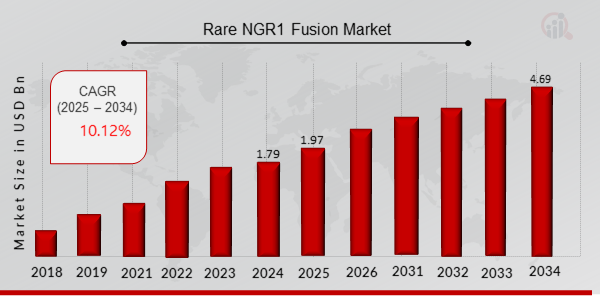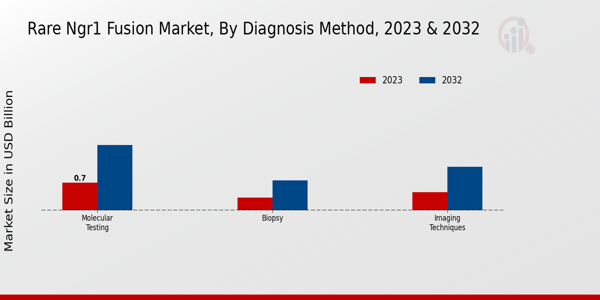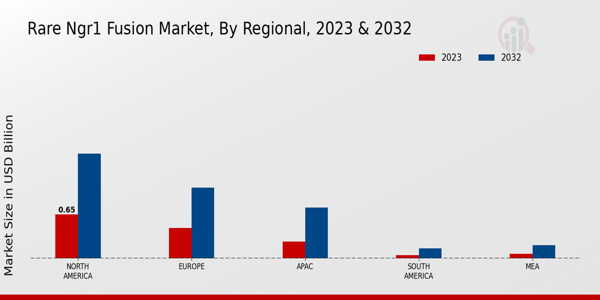Rare NGR1 Fusion Market Overview
As per MRFR analysis, the Rare NGR1 Fusion Market Size was estimated at 1.79 (USD Billion) in 2024. The Rare NGR1 Fusion Market Industry is expected to grow from 1.97 (USD Billion) in 2025 to 4.69 (USD Billion) till 2034, at a CAGR (growth rate) is expected to be around 10.12% during the forecast period (2025 - 2034).
Key Rare NGR1 Fusion Market Trends Highlighted
Growing awareness of personalized medicine is propelling the Rare NGR1 Fusion Market. As healthcare emphasizes targeted therapies, the demand for effective treatment options for rare diseases is increasing. This shift towards personalized medicine is accompanied by advancements in diagnostic technologies, which enable earlier and more accurate detection of such conditions. Additionally, collaborations between pharmaceutical companies and academic institutions are fostering innovation in drug development, further driving market growth. Opportunities in this market are abundant, especially in the realm of research and development. Companies can focus on creating therapies that target specific genetic mutations, which may increase treatment efficacy and patient outcomes.There is also potential for expanding geographical reach by entering emerging markets where rare diseases may be underdiagnosed. Investing in genetic research and leveraging technologies like CRISPR can also open new avenues for targeting rare genetic disorders effectively. Recently, companies have been emphasizing the importance of developing drugs that cater to unmet medical needs within this niche. Increased regulatory support for rare disease research is another trend seen as authorities aim to incentivize the creation of orphan drugs. There is a growing trend of patient-centric approaches in clinical trials, focusing on gathering insights from patients’ experiences.This shift not only improves the development process but also fosters trust and transparency between patients and pharmaceutical companies. The focus on sustainability and ethical business practices is becoming significant as well, where companies aim to balance profit-making with social responsibility. Together, these factors are shaping the current landscape of the Rare NGR1 Fusion Market, creating an environment ripe for innovation and growth.

Source: Primary Research, Secondary Research, MRFR Database and Analyst Review
Rare NGR1 Fusion Market Drivers
Increase in Prevalence of Rare Cancers Associated with NGR1 Fusion
The rising incidence of rare cancers, specifically those associated with NGR1 fusion, is a significant driver in the Rare NGR1 Fusion Market Industry. These elusive cancers often pose challenges in diagnosis and treatment, increasing the demand for specialized therapies and drugs targeting NGR1 fusion. As healthcare professionals and researchers unlock more about these rare conditions, there is a growing emphasis on developing targeted therapies that specifically address the genetic and molecular alterations associated with NGR1 fusion.Enhanced awareness about rare cancers among healthcare providers, coupled with increased funding for research, can accelerate the development of novel treatment options. Moreover, patient advocacy groups are playing a crucial role in raising awareness and funding for specific rare cancers, including those linked to NGR1 fusion. As a result, the market for therapeutics and diagnostic tools tailored for these cancers is expected to expand significantly, contributing to market growth.The ongoing research efforts aim not only to unveil more about the NGR1 fusion gene but also to monitor treatment responses better and personalize therapies, ultimately enhancing patient outcomes and driving further innovations in the Rare NGR1 Fusion Market Industry.
Advancements in Personalized Medicine
The advancements in personalized medicine are transforming the landscape of the Rare NGR1 Fusion Market Industry. Personalized medicine allows for treatments to be tailored to individual patient profiles, particularly those with specific genetic mutations such as NGR1 fusion. As healthcare continues to evolve towards precision therapies, there is a growing requirement for diagnostic tools that efficiently identify candidates suitable for targeted therapies.This trend is further supported by technological advancements in genomics, which facilitate the rapid identification and study of rare genetic alterations. The integration of personalized medicine into treatment protocols enables healthcare providers to match patients with the most effective therapies, enhancing treatment outcomes and minimizing side effects. This growing focus on personalized approaches in oncology is expected to significantly impact the demand for treatments targeting rare cancers, including those driven by NGR1 fusion.
Increased Research Funding and Collaboration
Increased research funding and collaborative efforts are vital drivers fuelling the growth of the Rare NGR1 Fusion Market Industry. Governments, private organizations and academic institutions are increasingly investing in the research of rare cancers and their associated molecular fusions like NGR1. This influx of funding promotes extensive research and development (R) activities, enabling the exploration of novel targeted therapies and the advancement of diagnostic technologies.Collaborations among pharmaceutical companies, biotechnology firms and research institutions facilitate knowledge sharing and accelerate the development of innovative treatments. Additionally, these partnerships often result in the pooling of resources and expertise, allowing for faster progress in clinical trials and more robust safety and efficacy data. As more stakeholders recognize the importance of addressing rare cancers, the research and development landscape is likely to witness continuous growth, driving the expansion of the Rare NGR1 Fusion Market Industry.
Rare NGR1 Fusion Market Segment Insights
Rare NGR1 Fusion Market Diagnosis Method Insights
The Diagnosis Method segment of the Rare NGR1 Fusion Market has established itself as a critical area of focus due to its significant role in identifying and managing rare genetic conditions. With an expected valuation of 1.47 USD Billion in 2023, this segment is poised for notable growth, driven primarily by advancements in diagnostic technologies and increasing awareness among healthcare providers regarding the importance of early detection. Within this segment, Molecular Testing stands out as a dominant approach, holding a valuation of 0.7 USD Billion in 2023 and projected to rise to 1.65 USD Billion by 2032, reflecting its majority holding in the overall market. This sub-segment is crucial as it provides precise genetic information, guiding treatment options and enabling targeted therapies, thus making it an essential tool for clinicians in managing rare NGR1 fusion cases effectively.
Following closely, Biopsy represents a significant method within the Diagnosis Method segment, valued at 0.32 USD Billion in 2023 and anticipated to grow to 0.75 USD Billion by 2032. This approach is vital for obtaining tissue samples that allow for comprehensive analysis, which is pivotal in accurately diagnosing and understanding tumor behavior associated with NGR1 fusions. Although it is currently among the less dominant methods, its importance cannot be understated, as biopsy results can often confirm molecular test findings and influence clinical decisions regarding patient care.
Imaging Techniques also play a noteworthy role in the overall diagnostic landscape, starting with a valuation of 0.45 USD Billion in 2023, projected to expand to 1.1 USD Billion by 2032. This segment is significant as imaging helps visualize anatomical structures and abnormalities, complementing molecular and biopsy findings. The advancements in imaging technologies, such as MRI and CT scans, have facilitated better insights into tumor localizations and characteristics, ultimately aiding in accurate diagnoses of rare NGR1 fusion cases.
Overall, the Diagnosis Method segment illustrates a dynamic landscape within the Rare NGR1 Fusion Market, characterized by rapid advancements and growing applications, which are essential for effective patient management and treatment pathways. The combination of these diagnostic approaches offers a comprehensive strategy for healthcare providers to address the challenges posed by rare NGR1 fusions effectively, enhancing patient outcomes in this specialized area of the Rare NGR1 Fusion Market.

Source: Primary Research, Secondary Research, MRFR Database and Analyst Review
Rare NGR1 Fusion Market End User Insights
With an anticipated CAGR of 10.12 from 2024 to 2032, the market demonstrates promising dynamics across various End User categories. Hospitals play a pivotal role as they are primary healthcare providers, leveraging advanced diagnostic techniques essential for detecting rare conditions. Furthermore, Diagnostic Laboratories are critical as they support high-throughput screening and testing capabilities, thus facilitating timely diagnosis and treatment plans.Research Institutions significantly contribute to the market by innovating new therapies and conducting essential studies related to rare NGR1 fusion. The synergy among these End Users ensures comprehensive patient care, driving the Rare NGR1 Fusion Market statistics forward while addressing the increasing prevalence of related health issues. Overall, the emphasis on enhanced diagnostic accuracy and transformative therapeutic solutions continues to be a major growth driver within the industry.
Rare NGR1 Fusion Market Therapeutic Approach Insights
This segment encompasses various strategies, including targeted therapy, chemotherapy and immunotherapy, each playing a crucial role in addressing the unique challenges faced by patients with rare NGR1 fusion disorders. Targeted therapy is significant due to its ability to specifically attack cancer cells while sparing healthy tissues, thereby improving patient outcomes.Chemotherapy continues to be a foundational approach, delivering broad-spectrum treatment that can be effective against various malignancies, although it often carries more side effects. Meanwhile, immunotherapy is emerging as a promising option, harnessing the body's immune system to combat tumors, reflecting a notable trend in the treatment landscape. As the Rare NGR1 Fusion Market evolves, the emphasis on these therapeutic strategies demonstrates the market's growing commitment to providing more effective and tailored therapies, driven by advancements in research and technology, which collectively influences Rare NGR1 Fusion Market data and industry dynamics.
Rare NGR1 Fusion Market Drug Type Insights
Various therapeutics are underlined in this segment, prominently featuring Small Molecules, Monoclonal Antibodies and Gene Therapy. Small Molecules often navigate the complexities of targeting precise pathways within cancer cells, making them a favored approach in treatment scenarios. Monoclonal Antibodies are recognized for their tailored efficacy and specificity in targeting cancer cells, contributing significantly to the industry's advancements.Gene Therapy, being a cutting-edge innovation, provides exciting opportunities to address genetic anomalies at their source, thus revolutionizing treatment methodologies. The strong performance of these elements demonstrates a robust Rare NGR1 Fusion Market segmentation underpinned by consistent advancements in medical research and technology. With an ever-evolving landscape, stakeholders are well-positioned to capitalize on the market growth, addressing challenges while leveraging opportunities presented by these drug types. The collective interplay of these factors creates a dynamic environment that ensures that the Rare NGR1 Fusion Market revenue continues on an upward trajectory amidst increasing demand for effective treatment options.
Rare NGR1 Fusion Market Regional Insights
North America emerges as a dominant force, holding a valuation of 0.65 USD Billion in 2023 and expected to grow to 1.55 USD Billion by 2032, indicating its majority holding in the market. Europe follows closely with a valuation of 0.45 USD Billion in 2023, projected to rise to 1.05 USD Billion, highlighting its substantial role in the industry. The APAC region, valued at 0.25 USD Billion, exhibits growth potential with projections of reaching 0.75 USD Billion by 2032.South America and MEA, although smaller, have valuations of 0.05 USD Billion and 0.07 USD Billion in 2023, respectively, with prospects growing to 0.15 USD Billion and 0.2 USD Billion, demonstrating emerging market interest. The trends within these regions indicate active research and development initiatives, coupled with rising awareness of rare diseases, driving market growth. Overall, the Rare NGR1 Fusion Market segmentation illustrates varying degrees of momentum, influenced by regional healthcare infrastructure and investment in innovative therapies.

Source: Primary Research, Secondary Research, MRFR Database and Analyst Review
Rare NGR1 Fusion Market Key Players and Competitive Insights
The Rare NGR1 Fusion Market is gaining significant traction due to the ongoing advancements in biotechnology and increasing clinical trials targeting rare diseases. This market segment is characterized by limited competition primarily due to the relative novelty of NGR1 fusions and the specialized nature of therapies developed to treat rare cancers associated with these genetic alterations. The competitive landscape is shaped by research institutions, biotech firms, and pharmaceutical companies focusing their efforts on understanding the implications of NGR1 fusion genes in cancer pathology. The race to develop effective therapeutic interventions is intensifying, with companies investing heavily in RD to expand their product portfolios and secure patents for novel treatments. As a result, players in this space are developing strategic alliances with clinical research organizations and engaging in partnerships with regulatory bodies to expedite the development of innovative drug candidates.Livent Corporation is carving a niche in the Rare NGR1 Fusion Market, leveraging its robust research capabilities and deep understanding of lithium-based products. Known for its cutting-edge technologies in extraction and production processes, Livent Corporation has established a strong presence that enables the efficient development of therapies tied to rare diseases. The company’s commitment to innovation is reflected in its strategic investments in RD, focused specifically on NGR1-related applications, placing it as a formidable player in this emerging segment. Livent’s notable strengths include its experienced team of researchers and partnerships with various academic institutions, which bolster its capability to bring forward novel treatments in the context of rare cancers linked to NGR1 fusion. By integrating advanced technologies with a keen eye on regulatory pathways, Livent Corporation is well-positioned to enhance its influence in the market.USA Rare Earth is establishing its footprint in the Rare NGR1 Fusion Market through its focus on providing high-quality rare earth materials that are crucial for advanced therapies. The company’s strengths lie in its innovative processes and commitment to sustainability, which resonate well with evolving market demands for environmentally friendly solutions in biotechnology. By positioning itself in the rare earth supply chain, USA Rare Earth is not only addressing the need for raw materials essential for the development of effective treatments but also ensuring its competitive advantage through resource accessibility. The company’s strategic vision includes forming collaborations and partnerships aimed at advancing research into NGR1 fusions, which could significantly enhance its product offerings and market reach. This approach allows USA Rare Earth to contribute to the burgeoning field of rare disease therapeutics while maximizing its growth potential in a rapidly evolving market.
Key Companies in the Rare NGR1 Fusion Market Include
- Livent Corporation
- USA Rare Earth
- Albemarle Corporation
- China Northern Rare Earth Group HighTech Co.
- Arafura Resources Limited
- Torex Gold Resources Inc.
- China Minmetals Rare Earth Co.
- Neo Performance Materials Inc.
- MP Materials Corp.
- Pensana Plc
- Rare Element Resources Ltd.
- Lynas Rare Earths Limited
- FMC Corporation
- Allkem Limited
Rare NGR1 Fusion Market Industry Developments
Recent developments in the Rare NGR1 Fusion Market reveal a dynamic landscape characterized by significant growth and strategic movements among key players such as Livent Corporation, USA Rare Earth, and Albemarle Corporation. Notably, China Northern Rare Earth Group High-Tech Co. continues to expand its production capabilities to meet the increasing demand for rare earth materials essential for advanced technologies. Similarly, Arafura Resources Limited has made strides in securing funding for its Nolans project, which is anticipated to enhance its market position. Recently, MP Materials Corp. has been focusing on expanding its operations, potentially influencing supply chains.In terms of mergers and acquisitions, Neo Performance Materials Inc. has been actively pursuing opportunities to consolidate its footprint within the market, showcasing a trend where companies like Lynas Rare Earths Limited and Pensana Plc seek collaborative ventures to strengthen their resource positions. This surge in activities is reflected in the overall market valuation growth, which can be attributed to heightened global interest in sustainable technologies and the critical role that rare earth elements play within emerging sectors. These advancements are shaping the future landscape of the rare earth market as competition intensifies and innovation accelerates.
Rare NGR1 Fusion Market Segmentation Insights
- Rare NGR1 Fusion Market Diagnosis Method Outlook
- Molecular Testing
- Biopsy
- Imaging Techniques
Rare NGR1 Fusion Market End User Outlook
- Hospitals
- Diagnostic Laboratories
- Research Institutions
Rare NGR1 Fusion Market Therapeutic Approach Outlook
- Targeted Therapy
- Chemotherapy
- Immunotherapy
Rare NGR1 Fusion Market Drug Type Outlook
- Small Molecules
- Monoclonal Antibodies
- Gene Therapy
Rare NGR1 Fusion Market Regional Outlook
- North America
- Europe
- South America
- Asia Pacific
- Middle East and Africa
| Report Attribute/Metric |
Details |
|
Market Size 2024
|
1.79 (USD Billion)
|
|
Market Size 2025
|
1.97 (USD Billion)
|
|
Market Size 2034
|
4.69 (USD Billion)
|
|
Compound Annual Growth Rate (CAGR)
|
10.12 % (2025 - 2034)
|
|
Report Coverage
|
Revenue Forecast, Competitive Landscape, Growth Factors, and Trends
|
|
Base Year
|
2024
|
|
Market Forecast Period
|
2025 - 2034
|
|
Historical Data
|
2020 - 2024
|
| Market Forecast Units |
USD Billion |
| Key Companies Profiled |
Livent Corporation, USA Rare Earth, Albemarle Corporation, China Northern Rare Earth Group HighTech Co., Arafura Resources Limited, Torex Gold Resources Inc., China Minmetals Rare Earth Co., Neo Performance Materials Inc., MP Materials Corp., Pensana Plc, Rare Element Resources Ltd., Lynas Rare Earths Limited, FMC Corporation, Allkem Limited |
| Segments Covered |
Diagnosis Method, End User, Therapeutic Approach, Drug Type, Regional |
| Key Market Opportunities |
1. Expanding global awareness initiatives, 2. Innovative treatment development, 3. Collaborative research funding, 4. Targeted patient advocacy programs, 5. Advanced genetic testing solutions |
| Key Market Dynamics |
1. increasing incidence rates, 2. growing research funding, 3. expanding treatment options, 4. heightened awareness and advocacy, 5. collaborations and partnerships |
| Countries Covered |
North America, Europe, APAC, South America, MEA |
Frequently Asked Questions (FAQ) :
The Rare NGR1 Fusion Market is expected to be valued at 4.69 USD Billion by 2034.
The market is projected to have a CAGR of 10.12% from 2025 to 2034.
North America holds the largest market share, valued at 0.65 USD Billion in 2023.
The market value in Europe is expected to reach 1.05 USD Billion by 2032.
Key players include Livent Corporation, USA Rare Earth, and Albemarle Corporation, among others.
The molecular testing segment is expected to be valued at 1.65 USD Billion in 2032.
The biopsy segment is expected to be valued at 0.75 USD Billion by 2032.
The imaging techniques segment is projected to be valued at 1.1 USD Billion in 2032.
In 2023, the market value for the APAC region is 0.25 USD Billion.
The market in South America is expected to grow to a value of 0.15 USD Billion by 2032.

















